Optimal Decisions on Greenness, Carbon Emission Reductions, and Flexibility for Imperfect Production with Partial Outsourcing
Abstract
1. Introduction
1.1. Research Gap
- Several researchers have developed imperfect production models involving manufacturing and remanufacturing in the same cycle [8,17]. Nevertheless, the existing literature does not yet consider manufacturing–remanufacturing in the same cycle, along with partial outsourcing and technology investment to reduce carbon emissions under VPRs.
- The literature has extensively discussed flexibility in the production process through VPR with variable UPC, where UPC is influenced by raw material cost, development cost, and tool/die cost [11,18,19]. However, to the best of the authors’ knowledge, the existing literature has not yet explored GL-dependent raw material costs for variable UPC.
1.2. Contribution
- An imperfect manufacturing–reworking system is designed in this study under the consideration of flexibility in the production process with the effect of technological investment to reduce the effect of carbon emissions.
- A product’s green-level-dependent unit production cost is considered in this study to enhance the biodegradability of the product.
- An imperfect production process is formulated in this study where demand is dependent on the selling price and GL of the product and the generation rate of defective items is random. A percentage of demand is outsourced to fulfill the demand and to overcome the shortages.
1.3. Orientation of the Manuscript
2. Previous Studies
2.1. Imperfect Production with Outsourcing
| Author(s) | Outsourcing | Demand Rate Depend | Defective Item | Production Rate | Rework | Investment |
|---|---|---|---|---|---|---|
| Murmu et al. [3] | NA | SP | NA | Constant | NA | Preservation |
| Kaur et al. [7] | Constant | Random | NA | Flexible | NA | NA |
| Sarkar et al. [18] | NA | Constant | Yes | Flexible | Yes | Setup |
| Sarkar et al. [22] | NA | Constant | Yes | Flexible | Yes | GT |
| Mishra et al. [23] | NA | Constant | NA | Constant | NA | GT |
| Mashud et al. [24] | NA | Constant | Yes | Constant | Yes | NA |
| Das et al. [25] | NA | Constant | NA | Constant | NA | NA |
| Heydar et al. [26] | NA | Constant | Yes | Flexible | Yes | GT |
| Giri et al. [27] | NA | SP | NA | Constant | NA | GT |
| Dey and Seok [28] | NA | Service | Random | Constant | NA | Inspection |
| Bachar et al. [29] | Variable | SP | Yes | Constant | Yes | NA |
| Lin et al. [30] | Constant | Constant | Yes | Constant | Yes | NA |
| Ma et al. [31] | NA | SP | NA | Flexible | NA | NA |
| Alfares et al. [32] | NC | SP | NA | Flexible | NA | NA |
| Sarkar et al. [33] | NC | SP | Yes | Flexible | Yes | Inspection |
| This study | Variable | SP and GL | Yes | Flexible | Yes | GT |
2.2. Green Level (GL)- and Selling-Price-Dependent Demand
2.3. Green Level (GL)-Dependent Variable Production Rate (VPR)
2.4. Carbon Emissions Reduction and Green Products
3. Problem Statement, and Assumptions
3.1. Problem Statement
3.2. Assumptions
- A flexible production system for single items with reworking is considered in this study. Owing to several factors such as machinery problems and the tardiness of labor, defective items are generated randomly. Repairable faulty items are reworked with some additional cost to make them perfect-quality items [8].
- In this global supply chain system, certain percentages of optimal lot size quantity are outsourced to avoid a shortage situation. It is considered that percentage of the total quantity is outsourced. In other words, indicates that all amounts are produced by the manufacturer, and indicates all order quantities are outsourced with no amount produced by the manufacturer. Thus, in this study, we considered partial outsourcing to achieve optimum profit [29].
- In this study, demand for the products depends on the selling price and GL of the product. Therefore, the demand for the product is .
- A VPR with variable UPC for this study is considered to make the study realistic and profitable. UPC depends on the GL of the product, i.e., GL and UPC are directly proportional. Therefore, the UPC is calculated by considering raw metrical cost, which depends on the GL of the product, development, and tool/die cost as [22].
- A huge amount of carbon is emitted during the setup of the production process, manufacturing, remanufacturing, outsourcing, and holding the perfect and reworked item. Thus, keeping green environment in mind, some investments are considered to reduce carbon emissions. The investment function is , and v is the efficiency of technology. Theoretically, investment tends to zero when and tends to m when [63].
4. Imperfect Production Model with Partial Outsourcing
4.1. Green Level (GL)-Dependent Unit Production Cost (UPC)
4.2. Setup Cost for Flexible Production System
4.3. Holding Cost for Perfect and Defective Products
4.4. Reworking Cost
4.5. Holding Cost of the Reworked Products
4.6. Fixed Outsourcing Cost
4.7. Variable Outsourcing Cost
4.8. Carbon Emissions Cost
4.9. Investment in Carbon Emission Reduction Technology
5. Solution Methodology
6. Numerical Experiment
6.1. Numerical Analysis under Partial Outsourcing for Different Distributed Defective Rates
6.2. Special Cases
6.2.1. Results without Considering Outsourcing
6.2.2. Results without Considering Investment for Carbon Emission Reduction
6.2.3. Results without Considering Green Level (GL)-Dependent Demand and Production Cost
6.2.4. Results under Fixed Production Rate
6.2.5. Results under Fixed Demand and Production Rate
6.2.6. Discussions and Comparisons
- By considering green technology investment, a production–inventory system was formulated by Mishra et al. [58]. However, they ignored the concept of variable demand and flexibility in the production rate. Moreover, they considered shortage instead of partial outsourcing.
- In a similar direction, a production–inventory model by considering reworking, partial outsourcing, and price-dependent variable demand was proposed by Bachar et al. [17]. The profit for their system was USD per cycle. However, they ignored the concept of GL for the demand variability and did not consider the investment to reduce carbon emissions. By considering the GL of the product and carbon emission reduction investment, the present study provides about higher profit. Thus, the GL of the product is very crucial nowadays for retailing industries.
- Alfares and Ghaithan [32] developed a production–inventory system under production-rate, demand, and cost variability. However, in their model, they do not consider the concept of partial outsourcing, reworking, or investment to reduce carbon emissions and the GL of the product. The profit for their system was USD per cycle. However, due to consideration of partial outsourcing, GL of the product, and investment to reduce carbon emissions, the present study provides better profit.
- This study converges with the Bachar et al. [29] model if one ignores the GL of the product and investment to reduce carbon emission. The profit for the Bachar et al. [29] model was USD per cycle under the consideration of VPR, price-dependent demand, and partial outsourcing. However, GL-dependent UPC and investment to reduce carbon emissions help to gain more profit for this current study.
7. Sensitivity Analysis
7.1. Sensitivity of Parameters Related to Demand
7.2. Sensitivity of Parameters Related to Unit Production Cost (UPC)
7.3. Sensitivity of the Parameters Related to Outsourcing on Total Profit
7.4. Sensitivity of Cost Parameters on Total Cost
7.5. Sensitivity for the Carbon Emission-Related Parameters on Total Cost
8. Managerial Insights
9. Conclusions
10. Limitations and Future Extension
Author Contributions
Funding
Data Availability Statement
Conflicts of Interest
Notations & Abbreviations
| Decision | Variables |
| rate of production for perfect and imperfect items (unit/cycle) | |
| G | level of greenness of the product (percentages) |
| production lot size (units/cycle) | |
| investment related to the carbon emission reduction technology (USD/cycle) | |
| unit selling price of products (USD/unit) | |
| Parameters | |
| initial market demand of the product (unit) | |
| price-sensitive scaling parameter related to demand | |
| GL-sensitive scaling parameter related to demand | |
| GL-sensitive shape parameter related to demand | |
| market demand of green product, | |
| raw material cost for the green product (USD/ unit) | |
| product development cost, which is inversely proportional to the production rate (USD/unit) | |
| cost related to tool/die, which is directly proportional to the production rate | |
| unit cost for production, which depends on GL and production rate (USD/unit) | |
| H | inventory level of the perfect product with the outsourced product (unit) |
| inventory level for the perfect quality product (unit) | |
| inventory level for reworking the defective product (unit) | |
| portion of outsourced items () | |
| K | setup cost (in-house) (USD/setup) |
| time in which products are produced, (year) | |
| constant cost for outsourcing (USD/unit) | |
| variable outsourcing cost per unit (USD/unit) | |
| amount of carbon emitted due to the setup of the complex process (kg/setup) | |
| connecting variable between setup cost and constant outsourcing cost, where , | |
| connecting variable between UPC and variable outsourcing cost, where and | |
| h | unit cost to hold the perfect item (USD/unit/unit time) |
| amount of emitted carbon due to holding perfect products per unit per unit time (kg/unit/unit time) | |
| portion of the randomly generated repairable product (percentages) | |
| randomly generated defective items, = (unit) | |
| expected value of randomly generated repairable product | |
| time to rework the defective items, when (year) | |
| rate of reworking of defective items (units/unit time) | |
| per-unit cost for reworking (USD/unit) | |
| amount of emitted carbon from the reworking process (kg/unit) | |
| unit cost to hold reworked product per unit time (USD/unit/unit time) | |
| amount of emitted carbon due to holding reworked products per unit per unit time (kg/unit/unit time) | |
| carbon tax per kg per cycle (USD/kg/cycle) | |
| m | carbon reduction technology efficiency |
| v | carbon emission reduction fraction |
| time duration when only demand is there without production under (year) | |
| replenishment cycle time (time unit) | |
| T | cycle time if (year) |
| total operating cost per cycle (USD/year) | |
| total expected profit (USD/cycle) | |
| Abbreviations | |
| GL | Green level |
| GT | Green technology |
| VPR | Variable production rate |
| UPC | Unit production cost |
| NA | Not applicable |
Appendix A. Calculation of First-Ordered Derivatives
References
- Kugele, A.S.H.; Sarkar, B. Reducing carbon emissions of a multi-stage smart production for biofuel towards sustainable development. Alex. Eng. J. 2023, 70, 93–113. [Google Scholar] [CrossRef]
- Gomes, S.; Lopes, J.M.; Nogueira, S. Willingness to pay more for green products: A critical challenge for Gen Z. J. Clean. Prod. 2023, 390, 136092. [Google Scholar] [CrossRef]
- Murmu, V.; Kumar, D.; Jha, A.K. Quality and selling price dependent sustainable perishable inventory policy: Lessons from Covid-19 pandemic. Oper. Manag. Res. 2023, 16, 408–432. [Google Scholar] [CrossRef]
- Sahadevan, V.K.; Mishra, U. A green manufacturer–retailer circular economic production model with carbon emissions and waste control. Environ. Dev. Sustain. 2023, 1–40, in press. [Google Scholar] [CrossRef]
- Mahato, F.; Mahato, C.; Mahata, G.C. Sustainable optimal production policies for an imperfect production system with trade credit under different carbon emission regulations. Environ. Dev. Sustain. 2023, 25, 10073–10099. [Google Scholar] [CrossRef]
- Li, H.; Chen, H.; Chai, J.; Shi, V. Private label sourcing for an e-tailer with agency selling and service provision. Eur. J. Oper. Res. 2023, 305, 114–127. [Google Scholar] [CrossRef]
- Kaur, H.; Singh, S.P.; Majumdar, A. Modelling joint outsourcing and offshoring decisions. Int. J. Prod. Res. 2019, 57, 4278–4309. [Google Scholar] [CrossRef]
- Dey, B.K.; Sarkar, B.; Seok, H. Cost-effective smart autonomation policy for a hybrid manufacturing-remanufacturing. Comput. Ind. Eng. 2021, 162, 107758. [Google Scholar] [CrossRef]
- Shah, N.H.; Rabari, K.; Patel, E. Greening efforts and deteriorating inventory policies for price-sensitive stock-dependent demand. Int. J. Syst. Sci. Oper. Logist. 2023, 10, 2022808. [Google Scholar] [CrossRef]
- Dey, B.K.; Bhuniya, S.; Sarkar, B. Involvement of controllable lead time and variable demand for a smart manufacturing system under a supply chain management. Expert Syst. Appl. 2021, 184, 115464. [Google Scholar] [CrossRef]
- Glock, C.H.; Grosse, E.H. The impact of controllable production rates on the performance of inventory systems: A systematic review of the literature. Eur. J. Oper. Res. 2021, 288, 703–720. [Google Scholar] [CrossRef]
- Sarkar, B.; Guchhait, R. Ramification of information asymmetry on a green supply chain management with the cap-trade, service, and vendor-managed inventory strategies. Electron. Commer. Res. Appl. 2023, 60, 101274. [Google Scholar] [CrossRef]
- Liu, Y.; Xu, L.; Sun, H.; Chen, B.; Wang, L. Optimization of carbon performance evaluation and its application to strategy decision for investment of green technology innovation. J. Environ. Manag. 2023, 325, 116593. [Google Scholar] [CrossRef] [PubMed]
- Fang, Z. Assessing the impact of renewable energy investment, green technology innovation, and industrialization on sustainable development: A case study of China. Renew. Energy 2023, 205, 772–782. [Google Scholar] [CrossRef]
- Pal, B.; Adhikari, S. Price-sensitive imperfect production inventory model with exponential partial backlogging. Int. J. Syst. Sci. Oper. Logist. 2019, 6, 27–41. [Google Scholar] [CrossRef]
- Feng, L.; Chan, Y.L.; Cárdenas-Barrón, L.E. Pricing and lot-sizing polices for perishable goods when the demand depends on selling price, displayed stocks, and expiration date. Int. J. Prod. Econ. 2017, 185, 11–20. [Google Scholar] [CrossRef]
- Bachar, R.K.; Bhuniya, S.; Ghosh, S.K.; Sarkar, B. Sustainable green production model considering variable demand, partial outsourcing, and rework. AIMS Environ. Sci. 2022, 9, 325–353. [Google Scholar] [CrossRef]
- Sarkar, M.; Park, K.S. Reduction of makespan through flexible production and remanufacturing to maintain the multi-stage automated complex production system. Comput. Ind. Eng. 2023, 177, 108993. [Google Scholar] [CrossRef]
- Ruidas, S.; Seikh, M.R.; Nayak, P.K. An EPQ model with stock and selling price dependent demand and variable production rate in interval environment. Int. J. Syst. Assur. Eng. Manag. 2020, 11, 385–399. [Google Scholar] [CrossRef]
- Sana, S.S. A production–inventory model in an imperfect production process. Eur. J. Oper. Res. 2010, 200, 451–464. [Google Scholar] [CrossRef]
- Pal, B.; Sana, S.S.; Chaudhuri, K. Joint pricing and ordering policy for two echelon imperfect production inventory model with two cycles. Int. J. Prod. Econ. 2014, 155, 229–238. [Google Scholar] [CrossRef]
- Sarkar, B.; Bhuniya, S. A sustainable flexible manufacturing–remanufacturing model with improved service and green investment under variable demand. Expert Syst. Appl. 2022, 202, 117154. [Google Scholar] [CrossRef]
- Mishra, U.; Wu, J.Z.; Sarkar, B. Optimum sustainable inventory management with backorder and deterioration under controllable carbon emissions. J. Clean. Prod. 2021, 279, 123699. [Google Scholar] [CrossRef]
- Mashud, A.H.M.; Pervin, M.; Mishra, U.; Daryanto, Y.; Tseng, M.L.; Lim, M.K. A sustainable inventory model with controllable carbon emissions in green-warehouse farms. J. Clean. Prod. 2021, 298, 126777. [Google Scholar] [CrossRef]
- Das, S.K.; Vincent, F.Y.; Roy, S.K.; Weber, G.W. Location–allocation problem for green efficient two-stage vehicle-based logistics system: A type-2 neutrosophic multi-objective modeling approach. Expert Syst. Appl. 2024, 238, 122174. [Google Scholar] [CrossRef]
- Heydari, J.; Govindan, K.; Basiri, Z. Balancing price and green quality in presence of consumer environmental awareness: A green supply chain coordination approach. Int. J. Prod. Res. 2021, 59, 1957–1975. [Google Scholar] [CrossRef]
- Giri, B.; Mondal, C.; Maiti, T. Analysing a closed-loop supply chain with selling price, warranty period and green sensitive consumer demand under revenue sharing contract. J. Clean. Prod. 2018, 190, 822–837. [Google Scholar] [CrossRef]
- Dey, B.K.; Seok, H. Intelligent inventory management with autonomation and service strategy. J. Intell. Manuf. 2024, 35, 307–330. [Google Scholar] [CrossRef]
- Bachar, R.K.; Bhuniya, S.; Ghosh, S.K.; AlArjani, A.; Attia, E.; Uddin, M.S.; Sarkar, B. Product outsourcing policy for a sustainable flexible manufacturing system with reworking and green investment. Math. Biosci. Eng. 2023, 20, 1376–1401. [Google Scholar] [CrossRef]
- Lin, J.; Naim, M.M.; Tang, O. In-house or outsourcing? The impact of remanufacturing strategies on the dynamics of component remanufacturing systems under lifecycle demand and returns. Eur. J. Oper. Res. 2024, in press. [Google Scholar] [CrossRef]
- Ma, S.; Zhang, L.L.; Cai, X. Optimizing joint technology selection, production planning and pricing decisions under emission tax: A Stackelberg game model and nested genetic algorithm. Expert Syst. Appl. 2024, 238, 122085. [Google Scholar] [CrossRef]
- Alfares, H.K.; Ghaithan, A.M. A generalized production-inventory model with variable production, demand, and cost rates. Arab. J. Sci. Eng. 2022, 47, 3963–3978. [Google Scholar] [CrossRef]
- Sarkar, B.; Dey, B.K.; Sarkar, M.; Kim, S.J. A smart production system with an autonomation technology and dual channel retailing. Comput. Ind. Eng. 2022, 173, 108607. [Google Scholar] [CrossRef]
- Sana, S.S. Optimum buffer stock during preventive maintenance in an imperfect production system. Math. Methods Appl. Sci. 2022, 45, 8928–8939. [Google Scholar] [CrossRef]
- Sepehri, A.; Gholamian, M.R. A green inventory model with imperfect items considering inspection process and quality improvement under different shortages scenarios. Environ. Dev. Sustain. 2023, 25, 3269–3297. [Google Scholar] [CrossRef]
- Naghshineh, B.; Carvalho, H. The implications of additive manufacturing technology adoption for supply chain resilience: A systematic search and review. Int. J. Prod. Econ. 2022, 247, 108387. [Google Scholar] [CrossRef]
- Friedrich, A.; Lange, A.; Elbert, R. Make-or-buy decisions for industrial additive manufacturing. J. Bus. Logist. 2022, 43, 623–653. [Google Scholar] [CrossRef]
- Xie, L.; Liu, Y.; Han, H.; Qiu, C.M. Outsourcing or reshoring? A manufacturer’s sourcing strategy in the presence of government subsidy. Eur. J. Oper. Res. 2023, 308, 131–149. [Google Scholar] [CrossRef]
- Deng, S.; Xu, J. Manufacturing and procurement outsourcing strategies of competing original equipment manufacturers. Eur. J. Oper. Res. 2023, 308, 884–896. [Google Scholar] [CrossRef]
- Cárdenas-Barrón, L.E.; Chung, K.J.; Treviño-Garza, G. Celebrating a century of the economic order quantity model in honor of Ford Whitman Harris. Int. J. Prod. Econ. 2014, 155, 1–7. [Google Scholar] [CrossRef]
- Agi, M.A.; Soni, H.N. Joint pricing and inventory decisions for perishable products with age-, stock-, and price-dependent demand rate. J. Oper. Res. Soc. 2020, 71, 85–99. [Google Scholar] [CrossRef]
- Jabarzare, N.; Rasti-Barzoki, M. A game theoretic approach for pricing and determining quality level through coordination contracts in a dual-channel supply chain including manufacturer and packaging company. Int. J. Prod. Econ. 2020, 221, 107480. [Google Scholar] [CrossRef]
- Dey, B.K.; Pareek, S.; Tayyab, M.; Sarkar, B. Autonomation policy to control work-in-process inventory in a smart production system. Int. J. Prod. Res. 2021, 59, 1258–1280. [Google Scholar] [CrossRef]
- Wang, L.; Song, Q. Pricing policies for dual-channel supply chain with green investment and sales effort under uncertain demand. Math. Comput. Simul. 2020, 171, 79–93. [Google Scholar] [CrossRef]
- Paul, A.; Pervin, M.; Roy, S.K.; Maculan, N.; Weber, G.W. A green inventory model with the effect of carbon taxation. Ann. Oper. Res. 2022, 309, 233–248. [Google Scholar] [CrossRef]
- Malleeswaran, B.; Uthayakumar, R. A single-manufacturer multi-retailer sustainable reworking model for green and environmental sensitive demand under discrete ordering cost reduction. J. Manag. Anal. 2023, 10, 109–128. [Google Scholar] [CrossRef]
- Punj, N.; Ahmi, A.; Tanwar, A.; Rahim, S.A. Mapping the field of green manufacturing: A bibliometric review of the literature and research frontiers. J. Clean. Prod. 2023, 423, 138729. [Google Scholar] [CrossRef]
- Khanlarzade, N.; Farughi, H. Modeling the Stackelberg game with a boundedly rational follower in deterioration supply chain-based interaction with the leader’s hybrid pricing strategy. Expert Syst. Appl. 2024, 237, 121302. [Google Scholar] [CrossRef]
- Ayed, S.; Sofiene, D.; Nidhal, R. Joint optimisation of maintenance and production policies considering random demand and variable production rate. Int. J. Prod. Res. 2012, 50, 6870–6885. [Google Scholar] [CrossRef]
- Min, D.; Chung, K. A joint optimal decision on shipment size and carbon reduction under direct shipment and peddling distribution strategies. Sustainability 2017, 9, 2061. [Google Scholar] [CrossRef]
- AlDurgam, M.; Adegbola, K.; Glock, C.H. A single-vendor single-manufacturer integrated inventory model with stochastic demand and variable production rate. Int. J. Prod. Econ. 2017, 191, 335–350. [Google Scholar] [CrossRef]
- Kim, H.; Kim, E. A hybrid manufacturing system with demand for intermediate goods and controllable make-to-stock production rate. Eur. J. Oper. Res. 2022, 303, 1244–1257. [Google Scholar] [CrossRef]
- Zhu, J.; Lu, Y.; Song, Z.; Shao, X.; Yue, X.G. The choice of green manufacturing modes under carbon tax and carbon quota. J. Clean. Prod. 2023, 384, 135336. [Google Scholar] [CrossRef]
- Barman, A.; De, P.K.; Chakraborty, A.K.; Lim, C.P.; Das, R. Optimal pricing policy in a three-layer dual-channel supply chain under government subsidy in green manufacturing. Math. Comput. Simul. 2023, 204, 401–429. [Google Scholar] [CrossRef]
- Sinha, R.K.; Chaturvedi, N.D. A review on carbon emission reduction in industries and planning emission limits. Renew. Sustain. Energy Rev. 2019, 114, 109304. [Google Scholar] [CrossRef]
- Das, S.K.; Roy, S.K. Effect of variable carbon emission in a multi-objective transportation-p-facility location problem under neutrosophic environment. Comput. Ind. Eng. 2019, 132, 311–324. [Google Scholar] [CrossRef]
- Das, S.K.; Roy, S.K.; Weber, G.W. Application of type-2 fuzzy logic to a multiobjective green solid transportation–location problem with dwell time under carbon tax, cap, and offset policy: Fuzzy versus nonfuzzy techniques. IEEE Trans. Fuzzy Syst. 2020, 28, 2711–2725. [Google Scholar] [CrossRef]
- Mishra, U.; Wu, J.Z.; Sarkar, B. A sustainable production-inventory model for a controllable carbon emissions rate under shortages. J. Clean. Prod. 2020, 256, 120268. [Google Scholar] [CrossRef]
- Sun, L.; Cao, X.; Alharthi, M.; Zhang, J.; Taghizadeh-Hesary, F.; Mohsin, M. Carbon emission transfer strategies in supply chain with lag time of emission reduction technologies and low-carbon preference of consumers. J. Clean. Prod. 2020, 264, 121664. [Google Scholar] [CrossRef]
- Zhang, W.; Li, J.; Li, G.; Guo, S. Emission reduction effect and carbon market efficiency of carbon emissions trading policy in China. Energy 2020, 196, 117117. [Google Scholar] [CrossRef]
- An, Y.; Zhou, D.; Yu, J.; Shi, X.; Wang, Q. Carbon emission reduction characteristics for China’s manufacturing firms: Implications for formulating carbon policies. J. Environ. Manag. 2021, 284, 112055. [Google Scholar] [CrossRef]
- Yang, Z.; Gao, W.; Han, Q.; Qi, L.; Cui, Y.; Chen, Y. Digitalization and carbon emissions: How does digital city construction affect china’s carbon emission reduction? Sustain. Cities Soc. 2022, 87, 104201. [Google Scholar] [CrossRef]
- Dey, B.K.; Datta, A.; Sarkar, B. Effectiveness of carbon policies and multi-period delay in payments in a global supply chain under remanufacturing consideration. J. Clean. Prod. 2023, 402, 136539. [Google Scholar] [CrossRef]
- Utama, D.M.; Santoso, I.; Hendrawan, Y.; Dania, W.A.P. A sustainable production-inventory model with CO2 emission, electricity and fuel consumption under quality degradation and stochastic demand: A case study in the agri-food industry. Environ. Dev. Sustain. 2024, 1–40, in press. [Google Scholar] [CrossRef]
- Seok, H.; Nof, S.Y.; Filip, F.G. Sustainability decision support system based on collaborative control theory. Annu. Rev. Control 2012, 36, 85–100. [Google Scholar] [CrossRef]
- Chauhan, R.; Majumder, A.; Kumar, V. The impact of adopting customization policy and sustainability for improving consumer service in a dual-channel retailing. J. Retail. Consum. Serv. 2023, 75, 103504. [Google Scholar] [CrossRef]
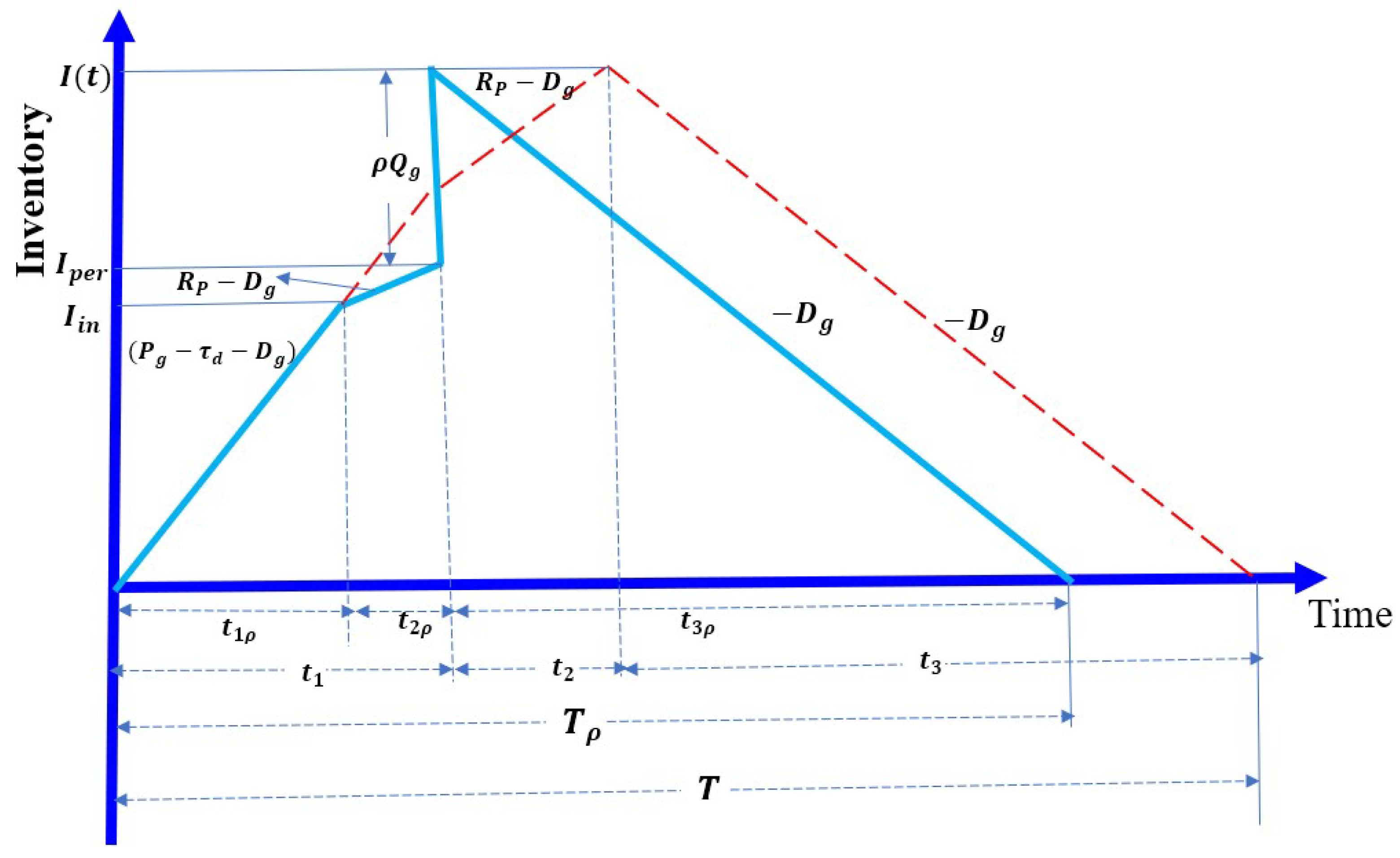

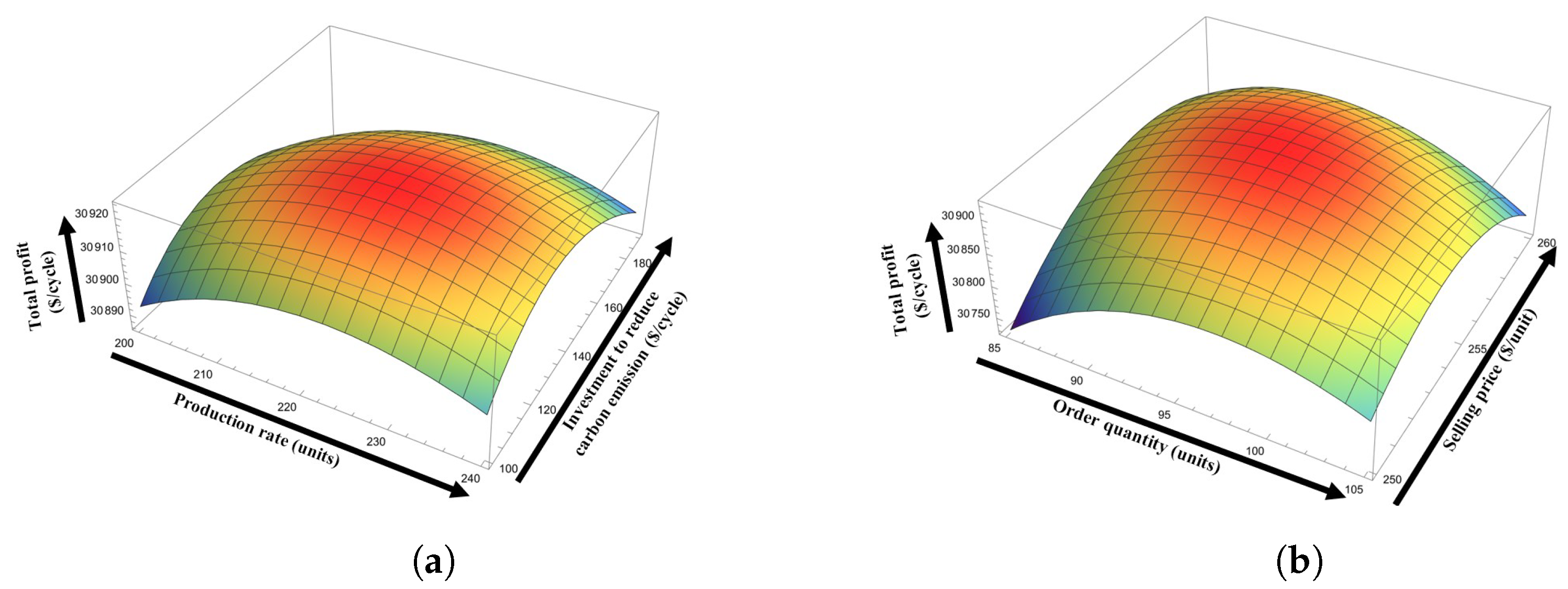
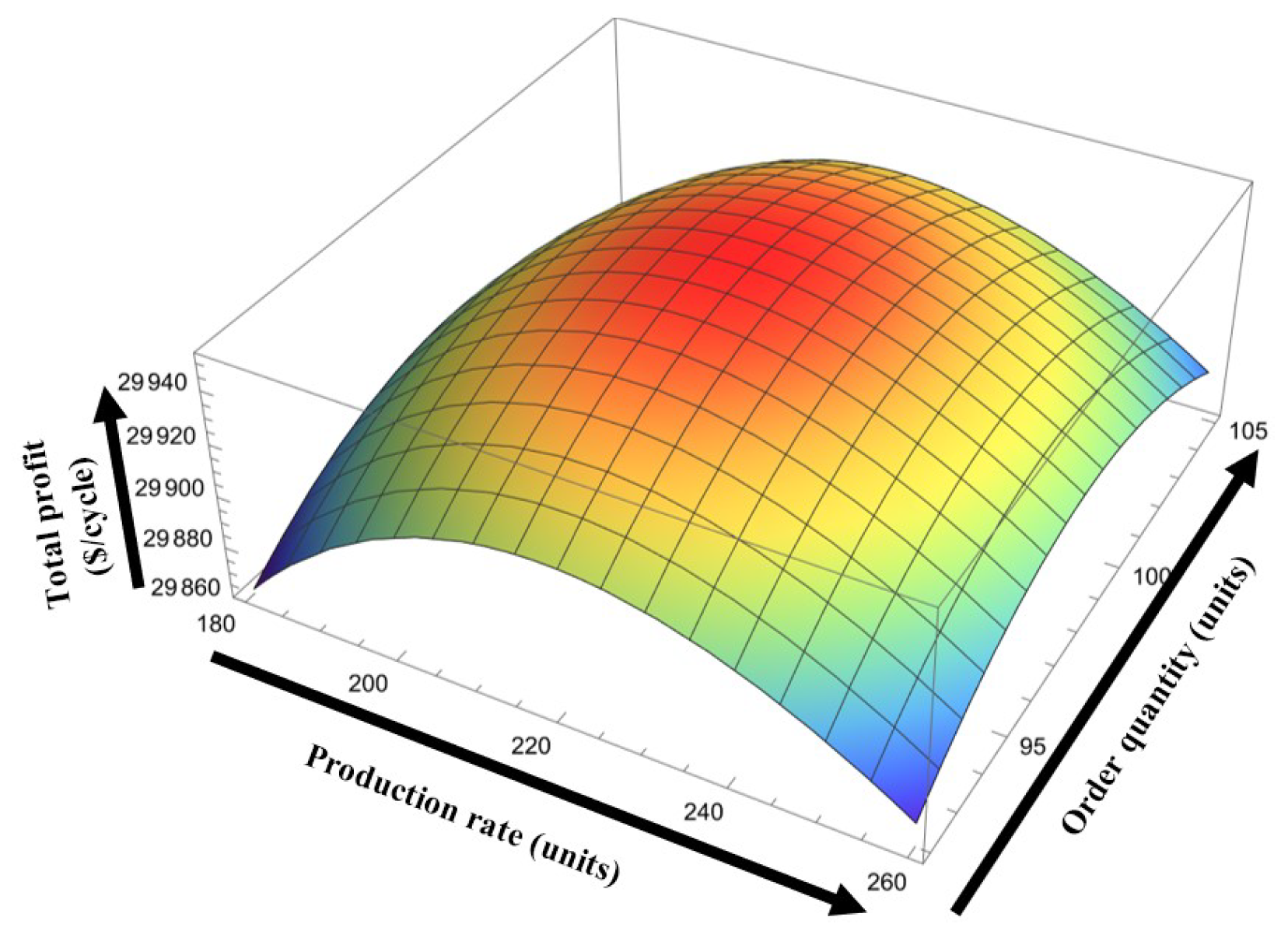
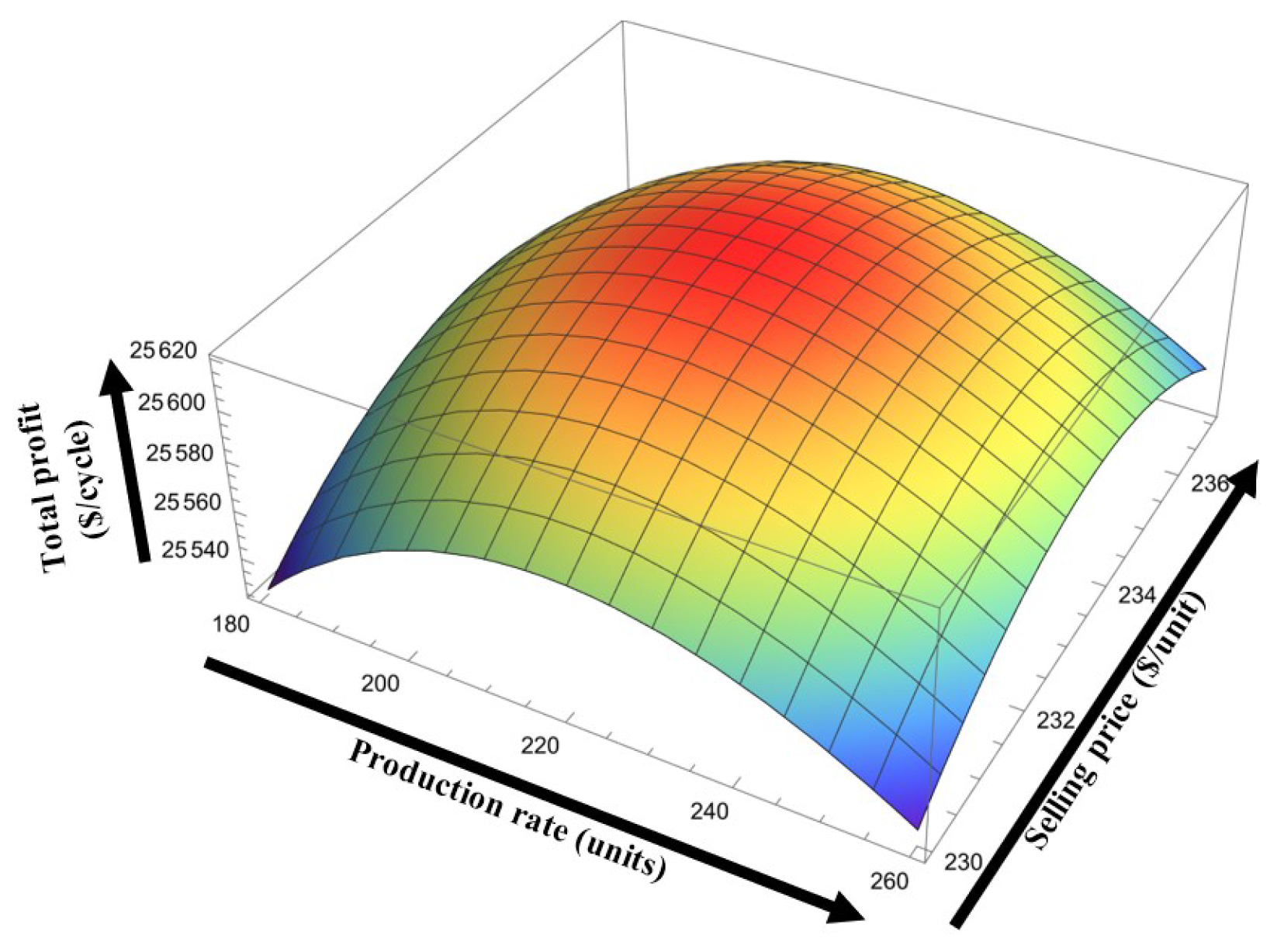


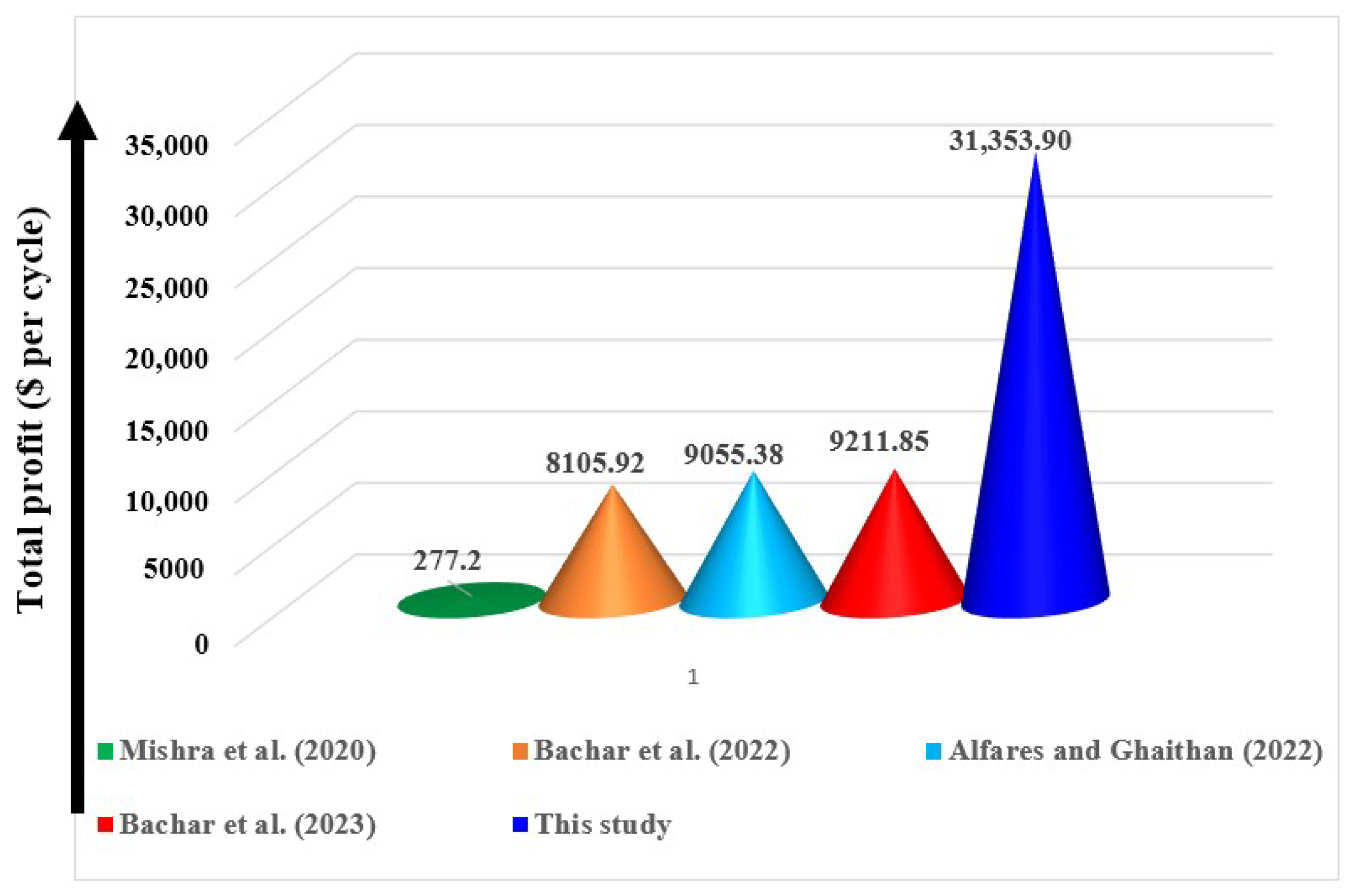
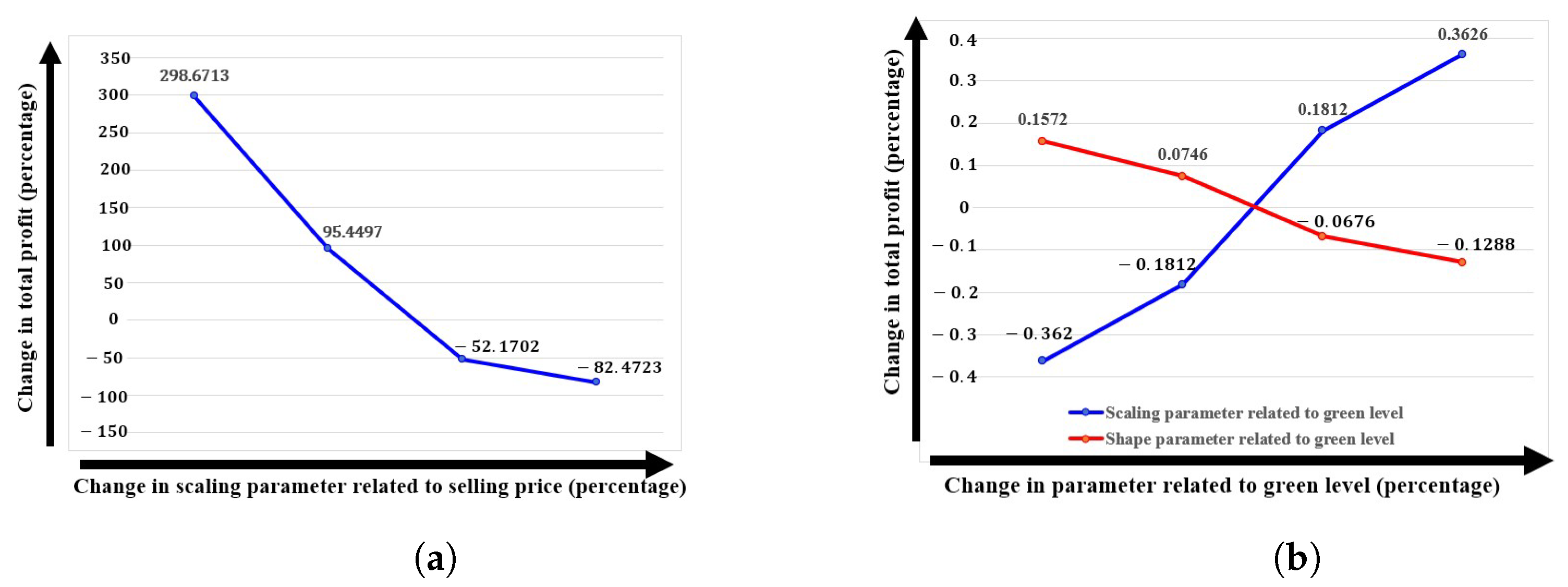
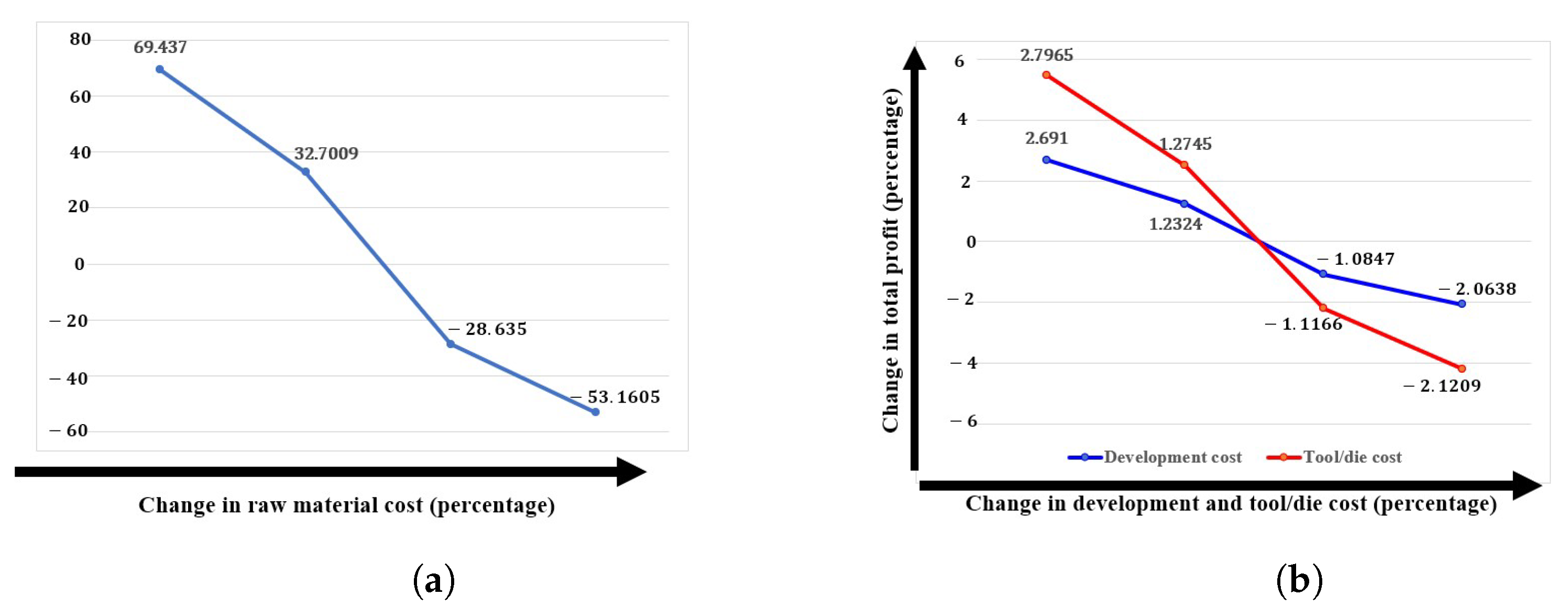
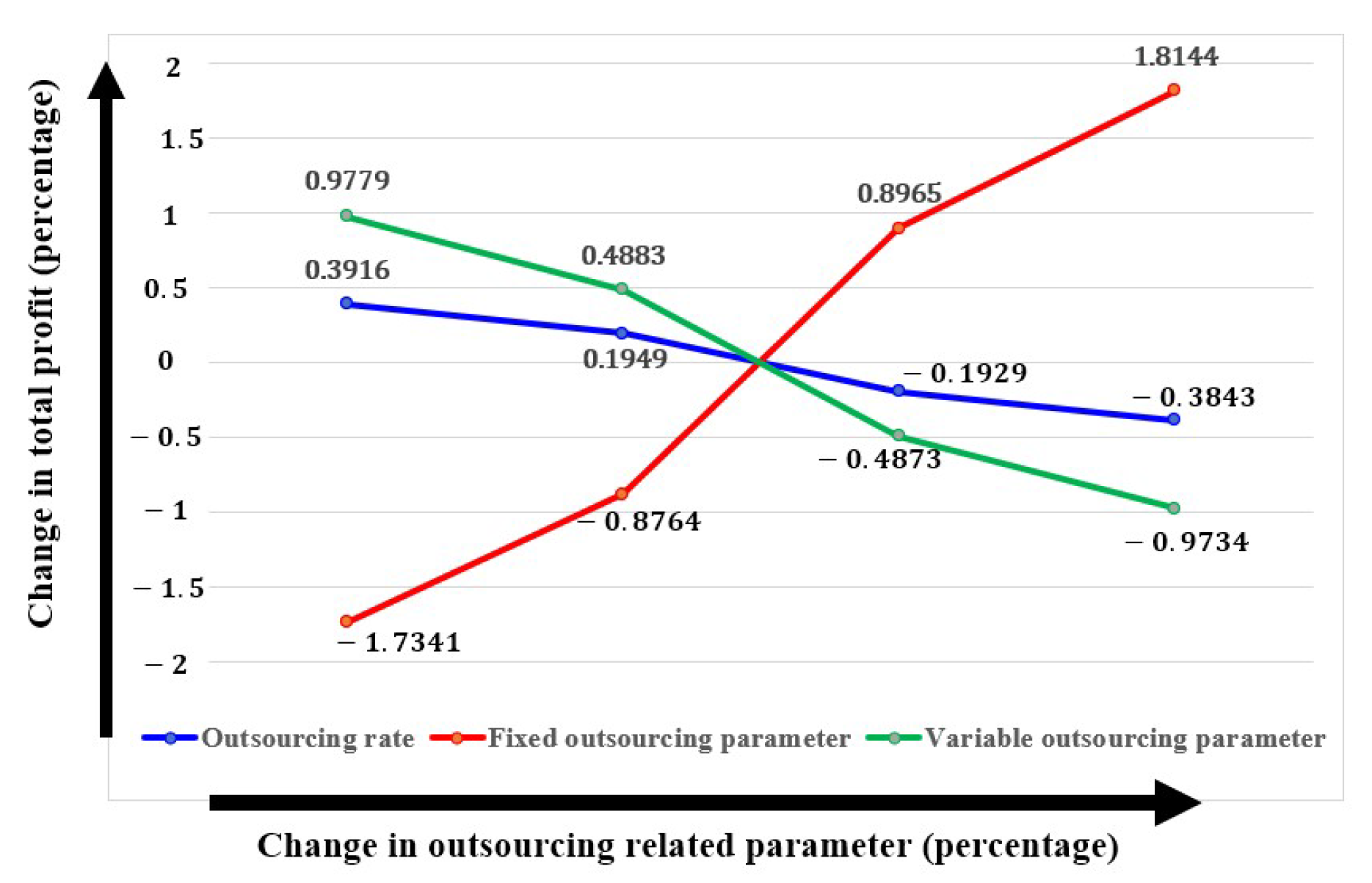
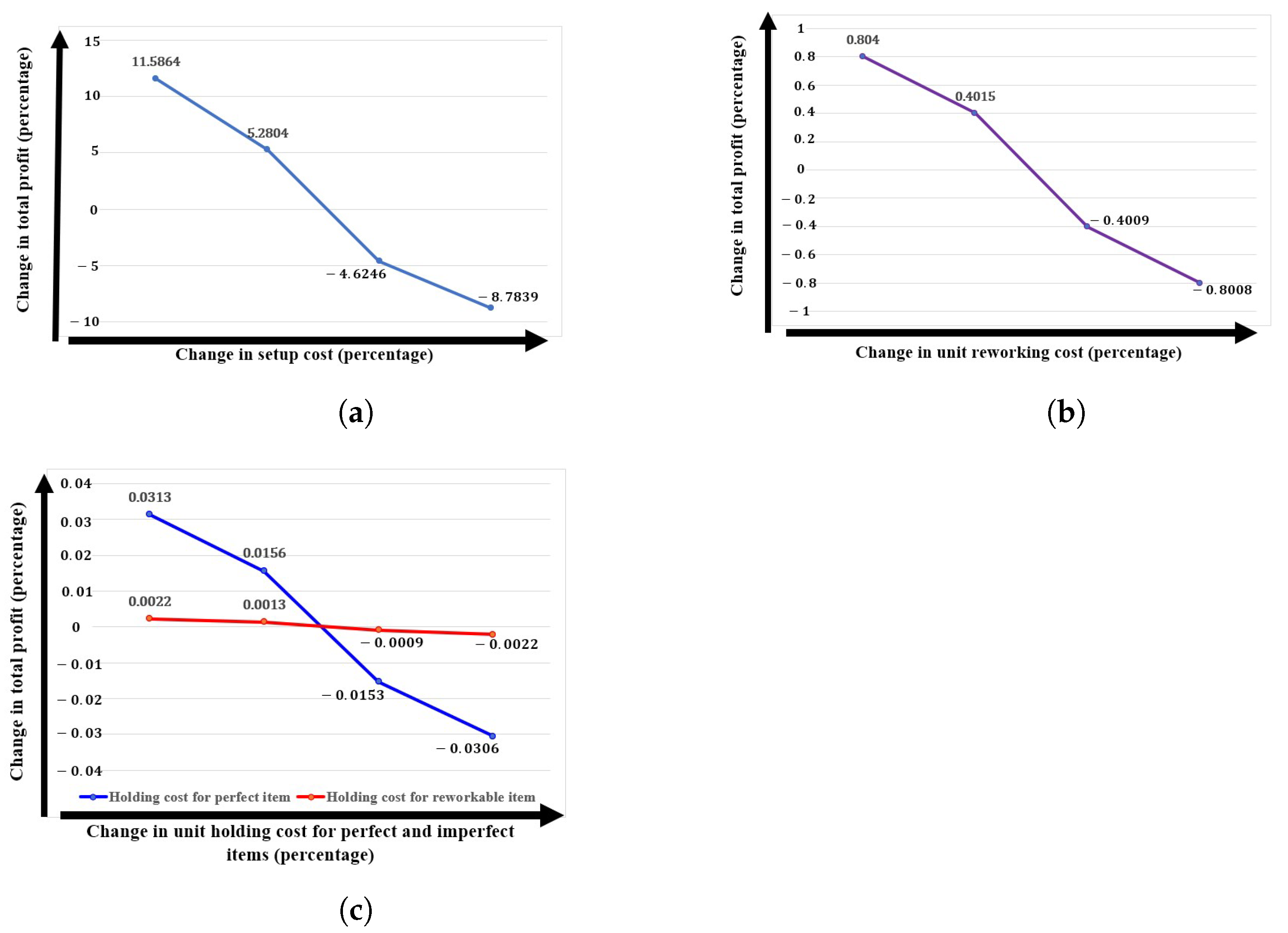
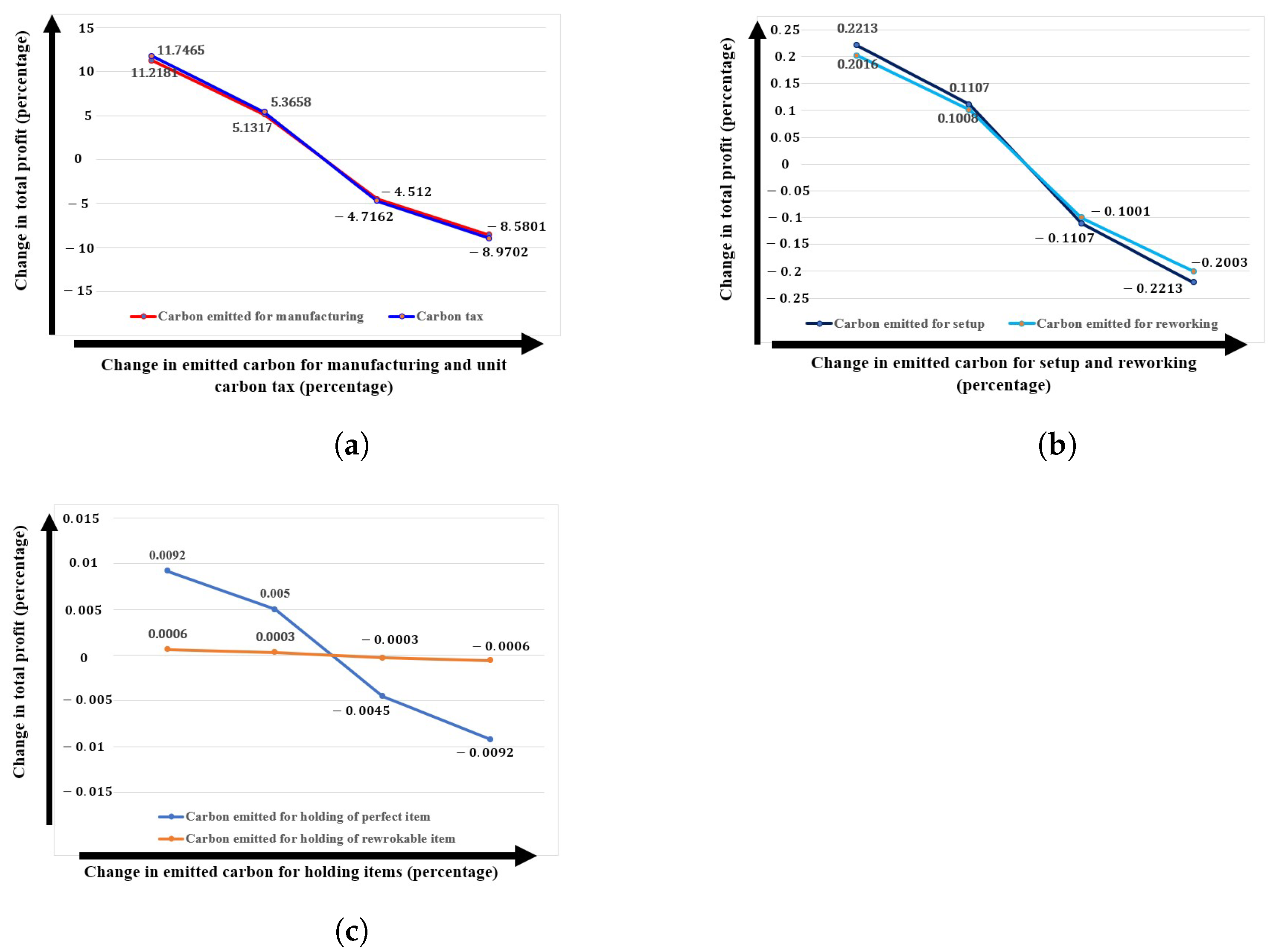
| Defective Rate Follows | Chi-Square Distribution | Uniform Distribution | Triangular Distribution | Reciprocal Distribution |
|---|---|---|---|---|
| Production rate (units) | 217.81 | 220.50 | 219.91 | 219.97 |
| Order quantity (units) | 92.82 | 92.03 | 101.59 | 92.18 |
| Green level (GL) (percentages) | 70% | 70% | 69% | 70% |
| Selling price (USD per unit) | 255.24 | 255.78 | 254.72 | 255.68 |
| Carbon emission reduction investment (USD per cycle) | 131.32 | 131.36 | 135.99 | 131.35 |
| Total profit (USD) | 31,353.90 | 31,018.00 | 31,108.80 | 31,078.40 |
| Different Cases | Without Outsourcing | Without Investment | Without Green Level | Fixed Production Rate | Fixed Demand and Production Rate |
|---|---|---|---|---|---|
| Production rate (units) | 222.02 | 218.12 | 217.10 | − | − |
| Order quantity (units) | 94.74 | 98.75 | 88.94 | 73.96 | 84.55 |
| Green level (GL) (percentages) | 70% | 68% | − | 69% | − |
| Selling price (USD per unit) | 255.25 | 251.58 | 233.83 | 311.80 | − |
| Carbon emission reduction investment (USD per cycle) | 134.87 | − | 129.22 | 120.22 | 126.82 |
| Total profit (USD) | 30,924.00 | 29,951.90 | 25,619.70 | 18,544.60 | 9793.41 |
Disclaimer/Publisher’s Note: The statements, opinions and data contained in all publications are solely those of the individual author(s) and contributor(s) and not of MDPI and/or the editor(s). MDPI and/or the editor(s) disclaim responsibility for any injury to people or property resulting from any ideas, methods, instructions or products referred to in the content. |
© 2024 by the authors. Licensee MDPI, Basel, Switzerland. This article is an open access article distributed under the terms and conditions of the Creative Commons Attribution (CC BY) license (https://creativecommons.org/licenses/by/4.0/).
Share and Cite
Dey, B.K.; Seok, H.; Chung, K. Optimal Decisions on Greenness, Carbon Emission Reductions, and Flexibility for Imperfect Production with Partial Outsourcing. Mathematics 2024, 12, 654. https://doi.org/10.3390/math12050654
Dey BK, Seok H, Chung K. Optimal Decisions on Greenness, Carbon Emission Reductions, and Flexibility for Imperfect Production with Partial Outsourcing. Mathematics. 2024; 12(5):654. https://doi.org/10.3390/math12050654
Chicago/Turabian StyleDey, Bikash Koli, Hyesung Seok, and Kwanghun Chung. 2024. "Optimal Decisions on Greenness, Carbon Emission Reductions, and Flexibility for Imperfect Production with Partial Outsourcing" Mathematics 12, no. 5: 654. https://doi.org/10.3390/math12050654
APA StyleDey, B. K., Seok, H., & Chung, K. (2024). Optimal Decisions on Greenness, Carbon Emission Reductions, and Flexibility for Imperfect Production with Partial Outsourcing. Mathematics, 12(5), 654. https://doi.org/10.3390/math12050654







